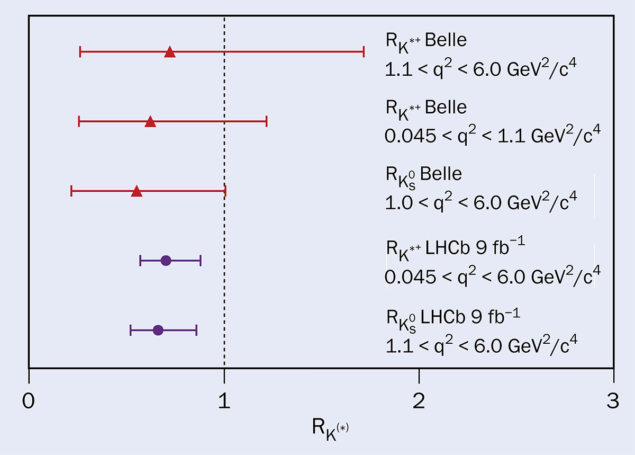
At a seminar at CERN today, the LHCb collaboration presented new tests of lepton universality in rare B-meson decays. While limited in statistical sensitivity, the results fit an intriguing pattern of recent results in the flavour sector, says the collaboration.
Since 2013, several measurements have hinted at deviations from lepton-flavour universality (LFU), a tenet of the Standard Model (SM) which treats charged leptons, ℓ, as identical apart from their masses. The measurements concern decay processes involving the transition between a bottom and a strange quark b→sℓ+ℓ–, which are strongly suppressed by the SM because they involve quantum corrections at the one-loop level (leading to branching fractions of one part in 106 or less). A powerful way to probe LFU is therefore to measure the ratio of B-meson decays to muons and electrons, for which the SM prediction, close-to-unity, is theoretically very clean.
In March this year, an LHCb measurement of RK = BR(B+→K+μ+μ–)/BR(B+→K+e+e–) based on the full LHC Run 1 and 2 dataset showed a 3.1σ difference from the SM prediction. This followed departures at the level of 2.2—2.5σ in the ratio RK*0 (which probes B0→K*0ℓ+ℓ– decays) reported by LHCb in 2017. The collaboration has also seen slight deficits in the ratio RpK, and departures from theory in measurements of the angular distribution of final-state particles and of branching fractions in neutral B-meson decays. None of the results is individually significant enough to constitute evidence of new physics. But taken together, say theorists, they point to a coherent pattern.
We are seeing a similar deficit of rare muon decays to rare electron decays that we have seen in other LFU tests
Harry Cliff
The latest LHCb analysis clocked the ratio of muons to electrons in the isospin-partner B-decays: B0→ KS0ℓ+ℓ– and B+→K*+ℓ+ℓ–. As well as being a first at the LHC, it’s the first single-experiment observation of these decays, and the most precise measurement yet of their branching ratios. Being difficult to reconstruct due to the presence of a long-lived KS0 in the final state, however, the sensitivity of the results is lower than for previous “RK” analyses. LHCb found R(KS0) = 0.66+0.2/-0.15 (stat) +0.02/-0.04 (syst) and R(K*+) = 0.70+0.18/-0.13 (stat) +0.03/-0.04 (syst), which are consistent with the SM at the level of 1.5 and 1.4σ, respectively.
“What is interesting is that we are seeing a similar deficit of rare muon decays to rare electron decays that we have seen in other LFU tests,” said Harry Cliff of the University of Cambridge, who presented the result on behalf of LHCb (in parallel with a presentation at Rencontres de Blois by Cambridge PhD student John Smeaton). “With many other LFU tests in progress using Run 1 and 2 data, there will be more to come on this puzzle soon. Then we have Run 3, where we expect to really zoom in on the measurements and obtain a detailed understanding.”
The experimental and theoretical status of the flavour anomalies in b→sℓ+ℓ and semi-leptonic B-decays will be the focus of the Flavour Anomaly Workshop at CERN on Wednesday 20 October, at which ATLAS and CMS activities will also be discussed, along with perspectives from theorists.







